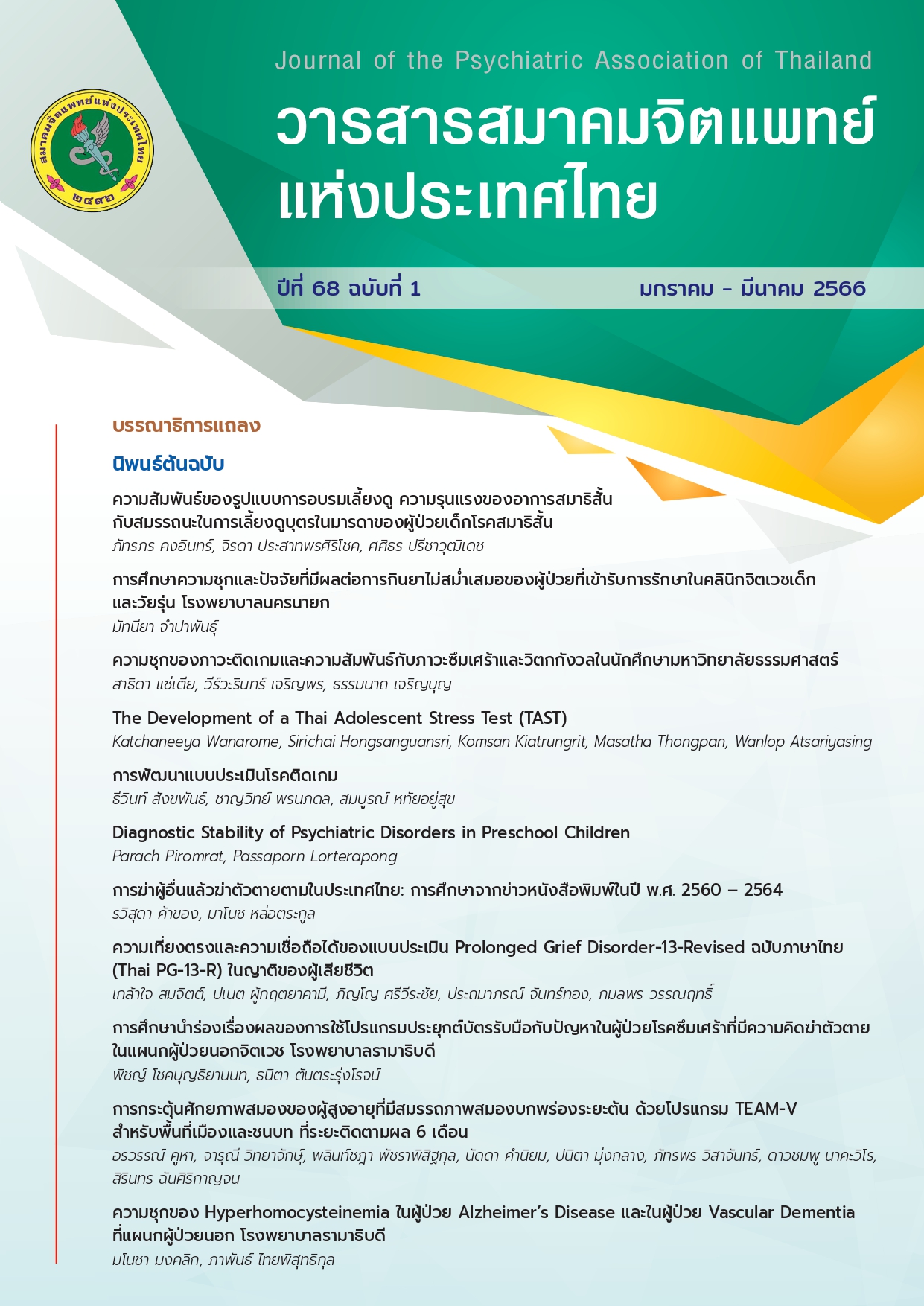The Development of Gaming Disorder Scale (GAME-S)
Main Article Content
Abstract
Objectives: To develop new reliable and valid screening scales for gaming disorder among Thai children and youths.
Methods: Gaming disorder scales (GAME-S) are newly developed screening scales composed of 2 versions including the Self version and Parent version. Each version contains 9 items assessing 3 domains of gaming disorder according to ICD-11 including impaired control over gaming, increasing priority given to gaming, and continuation or escalation of gaming despite negative consequences. The reliability of GAME-S was evaluated by internal consistency (Cronbach’s alpha) measurement. The exploratory factor analyses and confirmatory factor analyses were also performed to assess construct validity. The correlation between GAME-S score and Game Addiction Screening Test (GAST) score was determined by Pearson’s correlation coefficient.
Results: 1,992 subjects (1,243 children and 749 parents) from Bangkok, Surat Thani, Udon Thani, and Chiang Rai provinces participated in this study. The data were collected from schools (282 children and 196 parents), communities participated in a community-based treatment and prevention of gaming disorder (403 children and 417 parents), a therapeutic residential camp for gaming disorder application (136 children and 136 parents), and a medical college (422 medical students). Cronbach’s alpha coefficient of the Self version and Parent version were 0.92 and 0.96, respectively. Loading Factor analyzed by confirmatory factor analysis of the self-version and parent-version ranged from 0.66 - 0.81 and 0.79 - 0.86, respectively. Pearson’s correlation coefficient between GAME-S and GAST of Child and Parent’s version were 0.87 and 0.92, respectively.
Conclusion: GAME-S have good reliability and validity. There are several limitations of this study that should be addressed before further use in clinical or epidemiological studies related to gaming disorder.
Article Details

This work is licensed under a Creative Commons Attribution-NonCommercial-NoDerivatives 4.0 International License.
Articles submitted for consideration must not have been previously published or accepted for publication in any other journal, and must not be under review by any other journal.
References
World health organization [internet]. Gaming disorder; 2018 [cited 2018 Aug 4]. Available from: https://www.who.int/standards/classifications/frequently-asked-questions/gaming-disorder
Chia DX, Ng CW, Kandasami G, Seow MY, Choo CC, Chew PK, Lee C, Zhang MW. Prevalence of internet addiction and gaming disorders in Southeast Asia: A meta-analysis. Int J Environ Res Public Health 2020;17(7):2582.
Darvesh N, Radhakrishnan A, Lachance CC, Nincic V, Sharpe JP, Ghassemi M, Straus SE, Tricco AC. Exploring the prevalence of gaming disorder and Internet gaming disorder: a rapid scoping review. Syst Rev 2020;9(1):68.
ชาญวิทย์ พรนภดล, บัณฑิต ศรไพศาล, กุสุมาวดี คำเกลี้ยง. การพัฒนาแบบทดสอบการติดเกม. วารสารสมาคมจิตแพทย์แห่งประเทศไทย 2557;59(1): 3-14.
HealthyGamer Siriraj [อินเตอร์เน็ต]. กรุงเทพมหานคร: บทวิเคราะห์งานวิจัยสถานการณ์เด็กติดเกม มิถุนายน 2556; 2556 [เข้าถึงเมื่อ 24 ต.ค. 2562]. เข้าถึงได้จาก https://www.healthygamer.net/Library/detail/318
วรุณา กลกิจโกวินทร์, ชัยพร วิศิษฎ์พงศ์อารีย์, พิสาส์น เตชะเกษม, ชาญวิทย์ พรนภดล, บุษบา ศุภาวัฒนบดี. การติดเกมคอมพิวเตอร์ ปัจจัยเสี่ยงและปัจจัยป้องกันของเด็กนักเรียนในเขตดุสิต กรุงเทพมหานคร. วชิรเวชสาร 2559;59(3):1-14.
Erevik EK, Landrø H, Mattson ÅL, Kristensen JH, Kaur P, Pallesen S. Problem gaming and suicidality: A systematic literature review. Addict Behav Rep 2022:100419.
Zamani E, Chashmi M, Hedayati N. Effect of addiction to computer games on physical and mental health of female and male students of guidance school in city of Isfahan. Addict Health 2009;1(2):98-104.
HealthyGamer Siriraj [อินเตอร์เน็ต]. กรุงเทพมหานคร: บทวิเคราะห์งานวิจัยสถานการณ์เด็กติดเกม มิถุนายน 2557; 2557 [เข้าถึงเมื่อ 24 ต.ค. 2562]. เข้าถึงได้จาก https://www.healthygamer.net/Library/detail/318
Ayenigbara IO. Gaming disorder and effects of gaming on health: An overview. J Addict Med Ther Sci 2017;4(1):1-3.
Wei Q, Zhang S, Pan Y, Hu H, Chen F, Yin W, Lin Q, Pan S, Tham C, Wu J. Epidemiology of gaming disorder and its effect on anxiety and insomnia in Chinese ethnic minority adolescents. BMC Psychiatry 2022;22(1):1-9.
King DL, Delfabbro PH. The cognitive psychology of Internet gaming disorder. Clin Psychol Rev 2014;34(4):298-308.
Gentile DA, Bailey K, Bavelier D, Brockmyer JF, Cash H, Coyne SM, Doan A, Grant DS, Green CS, Griffiths M, Markle T. Internet gaming disorder in children and adolescents. Pediatrics 2017;140(Supplement2):S81-5.
Saunders JB, Hao W, Long J, King DL, Mann K, Fauth-Bühler M, Rumpf HJ, Bowden-Jones H, Rahimi-Movaghar A, Chung T, Chan E. Gaming disorder: Its delineation as an important condition for diagnosis, management, and prevention. J Behav Addict 2017;6(3):271-9.
Yoon S, Yang Y, Ro E, Ahn WY, Kim J, Shin SH, Chey J, Choi KH. Reliability, and convergent and discriminant validity of gaming disorder scales: a meta-analysis. Front Psychol 2021:5659.
Lemmens JS, Valkenburg PM, Peter J. Development and validation of a game addiction scale for adolescents. Media Psychol 2009;12(1):77-95.
Pontes HM, Griffiths MD. Measuring DSM-5 internet gaming disorder: Development and validation of a short psychometric scale. Comput Human Behav 2015;45:137-43.
Király O, Sleczka P, Pontes HM, Urbán R, Griffiths MD, Demetrovics Z. Validation of the Ten-Item Internet Gaming Disorder Test (IGDT-10) and evaluation of the nine DSM-5 Internet Gaming Disorder criteria. Addict Behav 2017;64:253-260.
Yılmaz E, Griffiths MD, Kan A. Development and validation of videogame addiction scale for children (VASC). Int J Ment Health Addict 2017;15(4):869-82.
สำนักบริหารการทะเบียน [อินเตอร์เน็ต]. กรุงเทพมหานคร: จำนวนประชากรแยกรายอายุ กรุงเทพมหานคร เดือน ธันวาคม พ.ศ. 2562; 2562 [เข้าถึงเมื่อ 21 ธ.ค. 2562]. เข้าถึงได้จาก https://stat.bora.dopa.go.th/stat/statnew/statMONTH/statmonth
King DL, Chamberlain SR, Carragher N, Billieux J, Stein D, Mueller K, et al. Screening and assessment tools for gaming disorder: A comprehensive systematic review. Clin Psychol Rev 2020;77:101831.
Robinson M, Doherty DA, Cannon J, Hickey M, Rosenthal SL, Marino JL, et al. Comparing adolescent and parent reports of externalizing problems: A longitudinal population-based study. Br J Dev Psychol 2019;37(2):247-68.
Stevens MW, Dorstyn D, Delfabbro PH, King DL. Global prevalence of gaming disorder: A systematic review and meta-analysis. Aust N Z J Psychiatry 2021;55(6):553-68.
Kim HS, Son G, Roh EB, Ahn WY, Kim J, Shin SH, et al. Prevalence of gaming disorder: A meta-analysis. Addict Behav 2022;126:107183.
Taechoyotin P, Tongrod P, Thaweerungruangkul T, Towattananon N, Teekapakvisit P, Aksornpusitpong C, et al. Prevalence and associated factors of internet gaming disorder among secondary school students in rural community, Thailand: a cross-sectional study. BMC Res Notes 2020;13(1):11.
Chupradit S, Kaewmamuang N, Kienngam N, Chupradit P. Prevalence and correlates between game addiction and stress of adolescents in Chiang Mai, Thailand. Indian J Public Health Res Dev 2019;10:1091.
Apisitwasana N, Perngparn U, Cottler LB. Gaming addiction situation among elementary school students in Bangkok, Thailand. Indian J Public Health Res Dev 2017;8(2).


